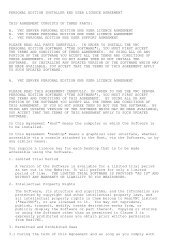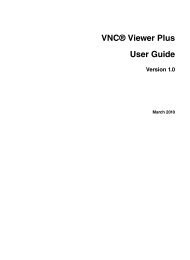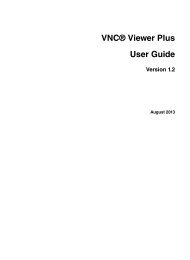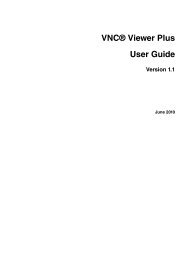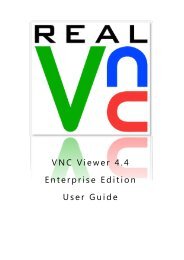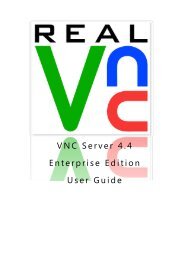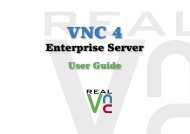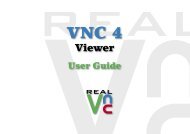VNC User Guide - RealVNC
VNC User Guide - RealVNC
VNC User Guide - RealVNC
You also want an ePaper? Increase the reach of your titles
YUMPU automatically turns print PDFs into web optimized ePapers that Google loves.
Chapter 7: Making Connections Secure<br />
In certain circumstances, you may be able to conditionally display connection prompts:<br />
• For <strong>VNC</strong> Server in Service Mode (Windows and Mac OS X), choose Show prompt only if user<br />
logged on in order to automatically accept connections when no host computer user is currently<br />
logged on (and therefore unlikely to be present). Note that at least one newly-connected user must then<br />
log on to the operating system of the host computer in order to continue. Subsequently, connection<br />
prompts are displayed again, for this user to accept or reject.<br />
• For <strong>VNC</strong> Server in Virtual Mode (UNIX/Linux), choose Show prompt only if user connected to<br />
automatically accept the first connection (since no host computer user can be ‘present’ at a virtual<br />
desktop). Subsequently, connection prompts are displayed again, for this user to accept or reject.<br />
For more information on notifications, see Notifying when users connect on page 91.<br />
Restricting features for particular connected users<br />
A set of <strong>VNC</strong> permissions is granted to each user who connects to <strong>VNC</strong> Server (Enterprise) or <strong>VNC</strong> Server<br />
(Personal) using either of the following authentication mechanisms:<br />
• System authentication. See Authenticating using host computer user credentials on page 98.<br />
• Single sign-on. See Authenticating automatically using client computer user credentials on page 105.<br />
Note this authentication mechanism is only available in <strong>VNC</strong> Server (Enterprise).<br />
Note: <strong>VNC</strong> Server (Free) does not support <strong>VNC</strong> permissions. Upgrade the host computer to <strong>VNC</strong> Server<br />
(Enterprise) or <strong>VNC</strong> Server (Personal) if security and flexibility are important to you.<br />
<strong>VNC</strong> permissions control which Real<strong>VNC</strong> remote control features a connected user is allowed to use. By<br />
default, a user supplying the credentials:<br />
• Of a host computer user with administrative privileges is granted a Full set of <strong>VNC</strong> permissions.<br />
• Of any other host computer user is granted a Default set of <strong>VNC</strong> permissions.<br />
114 <strong>VNC</strong> <strong>User</strong> <strong>Guide</strong>



